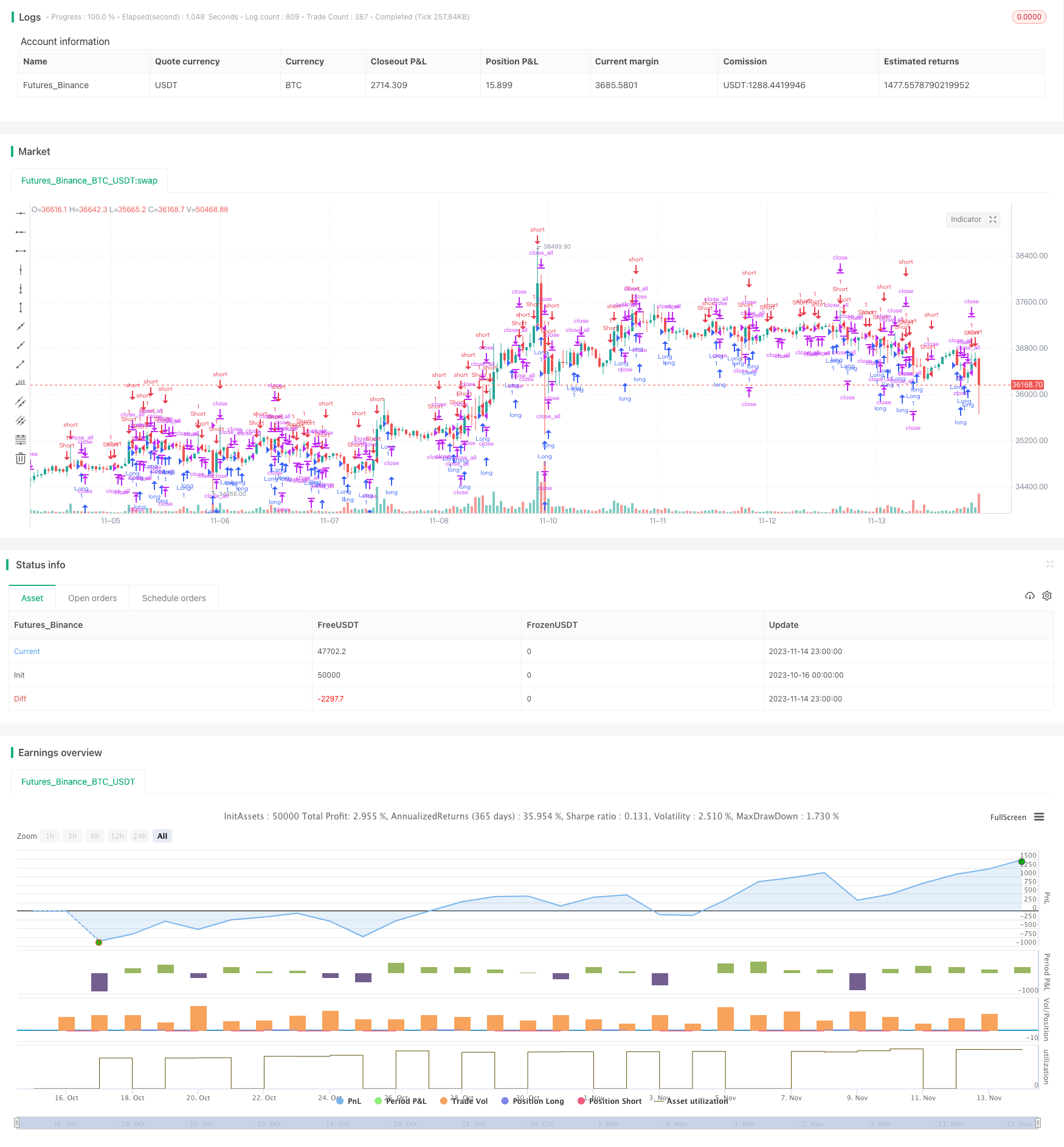
概述
该策略基于K线的实体长度来判断多空方向。它计算最近30根K线的平均实体长度,当阳线实体长度大于平均实体长度时做多,当阴线实体长度大于平均实体长度时做空。
策略原理
该策略首先计算K线的实体长度body,及最近30根K线实体长度的平均值sbody。
当今日K线为阴线(bar==-1),且实体长度大于平均实体长度时,打开多单(up1)。
当今日K线为阳线(bar==1),且实体长度大于平均实体长度时,打开空单(dn1)。
多单打开后,如果今日K线为阳线(bar==1),且当前头寸为盈利状态,则平仓多单。
空单打开后,如果今日K线为阴线(bar==-1),且当前头寸为盈利状态,则平仓空单。
该策略简单有效地利用了K线实体的长度来判断行情趋势,实体越长表示趋势越强,因此以实体长度作为判断多空的依据。
优势分析
该策略具有以下优势:
策略思路简单明了,容易理解和实现。
利用K线实体长度判断趋势,避免被噪音干扰。
采用动态平均值计算,可以适应市场的变化。
设置盈利平仓条件,可以提高策略收益率。
可配置策略参数,适用于不同市场环境。
风险分析
该策略也存在一些风险:
实体较长不一定代表强势趋势,可能是正常波动。
平均实体长度的时间窗口设定不当可能导致错失交易机会。
突发事件可能导致策略亏损。
多空头寸持有时间过长可能导致亏损扩大。
对应风险的解决方法:
结合其它指标判断趋势,避免错 trades。
测试不同参数取值,优化平均实体长度的计算。
设置止损止盈条件,控制单次亏损。
优化开仓和平仓逻辑,避免持仓时间过长。
优化方向
该策略可以从以下方面进行优化:
结合MACD、RSI等指标判断趋势,避免因常规波动产生错误信号。
测试不同的平均实体长度时间窗口参数,寻找最优参数组合。
添加开仓量控制逻辑,随着亏损次数增加逐步减少开仓量。
设置移动止损或利润率止损退出条件,控制单次亏损比例。
优化开仓和平仓条件,避免无效交易。例如连续3根K线实体较长再开仓。
在特定时间段或重要数据发布前后避开交易,控制汇率冲击带来的亏损。
总结
该策略整体思路清晰易懂,通过比较K线实体与其平均长度来判断入场时机。策略优化空间较大,可从多方面入手进行优化调整,使策略参数更符合不同市场环境。整体来说,该策略作为一个量化交易入门策略足够简单可靠,适合新手 traders 使用和学习。通过不断优化和组合更多指标,可以进一步提高策略收益率和稳定性。
/*backtest
start: 2023-10-16 00:00:00
end: 2023-11-15 00:00:00
period: 1h
basePeriod: 15m
exchanges: [{"eid":"Futures_Binance","currency":"BTC_USDT"}]
*/
//Noro
//2018
//@version=3
strategy(title = "Noro's ColorBar Strategy v1.0", shorttitle = "ColorBar str v1.0", overlay = true, default_qty_type = strategy.percent_of_equity, default_qty_value = 100.0, pyramiding = 0)
//Settings
needlong = input(true, defval = true, title = "Long")
needshort = input(true, defval = true, title = "Short")
usebody = input(true, defval = true, title = "Use body")
fromyear = input(1900, defval = 1900, minval = 1900, maxval = 2100, title = "From Year")
toyear = input(2100, defval = 2100, minval = 1900, maxval = 2100, title = "To Year")
frommonth = input(01, defval = 01, minval = 01, maxval = 12, title = "From Month")
tomonth = input(12, defval = 12, minval = 01, maxval = 12, title = "To Month")
fromday = input(01, defval = 01, minval = 01, maxval = 31, title = "From day")
today = input(31, defval = 31, minval = 01, maxval = 31, title = "To day")
//Signals
bar = close > open ? 1 : close < open ? - 1 : 0
body = abs(close - open)
sbody = ema(body, 30)
up1 = bar == -1 and (body > sbody or usebody == false)
dn1 = bar == 1 and (body > sbody or usebody == false)
plus = (close > strategy.position_avg_price and strategy.position_size > 0) or (close < strategy.position_avg_price and strategy.position_size < 0)
exit = ((strategy.position_size > 0 and bar == 1) or (strategy.position_size < 0 and bar == -1)) and plus
if up1
strategy.entry("Long", strategy.long, needlong == false ? 0 : na, when=(time > timestamp(fromyear, frommonth, 01, 00, 00) and time < timestamp(toyear, tomonth, 31, 00, 00)))
if dn1
strategy.entry("Short", strategy.short, needshort == false ? 0 : na, when=(time > timestamp(fromyear, frommonth, 01, 00, 00) and time < timestamp(toyear, tomonth, 31, 00, 00)))
if time > timestamp(toyear, tomonth, 31, 00, 00) or exit
strategy.close_all()